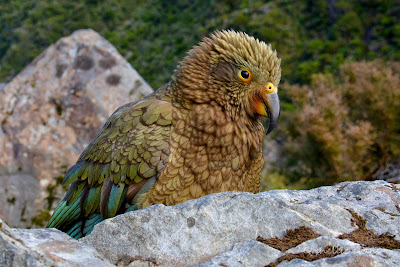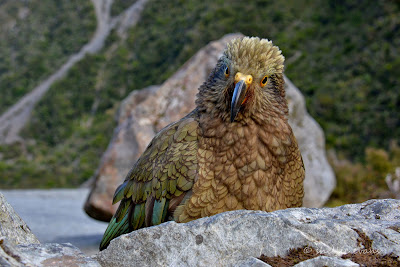And after all the rain we experienced on the West Coast, it’s also a surprise to see how dry it is on this side of the Southern Alps. The Canterbury High Country is still in drought mode, there has been very little rain here for many months.
We stop on the side of the road so I can take a photo of the rig with the mountains behind, I’m sure these will now be covered in snow after the big dump a week or so ago. Ever patient David pulls up again after we cross the river so I can get another shot looking back up the valley past the long Waimakariri River bridge.
The road hugs the bottom of the Black Range mountains which form a backdrop to the huge expanse of the braided Waimakariri River, one of the largest braided river systems in NZ. It’s not long before we pull up again. The view is absolutely stunning, the willows below the lookout are in the the final throes of their autumnal colours, the swampy backwash of the river a vivid blue.
I stitched this pano together which is a little cramped (I should have used my phone, it does panos better than my camera), with the road on either side, but it gives an indication of the width of the river flats; across the river to the left is the Dome (1938m) and to the right The Pyramid (1608m). Click on the photo to see in enlarged.
Just before the road leaves the river near Mt Horrible (with Mt Misery behind- someone was obviously having a bad day when they dreamed up those names) there’s a a short side road to the historic Mt White bridge. The trans-alpine railway meets and runs alongside the river here on it’s way through Arthurs Pass.
The cold crystal clear waters of the Waimakariri pass underneath the bridge…
…and head east through numerous gorges before breaking free once again and crossing the Canterbury Plains before exiting into the Pacific Ocean, south of Woodend Beach near Christchurch. A very familiar river for my father’s family. Dad was originally from Woodend and his extended family still whitebait near the river's mouth whenever they are able to.
Leaving the river behind, the road stretches ahead of us, long & straight. I’m falling in love with the high country again!
And just over the brow at the end of the road above, is our next destination, the beautiful & tranquil hour glass shaped, Lake Pearson (or Moana Rua), resting in a hollow at the bottom of Purple Hill (1680m).
There’s a DOC camp here right on the lake’s edge, although with the drought the edge has receded quite a bit.
The camp site is a popular stop over for many people on their way back and forth, from east to west coast, through Arthurs Pass. There are numerous parking spots under the willows or in amongst the wild & spiny matagouri bushes. Most smaller vans & tents set up camp tucked under the trees, this gives them some protection from rain (not likely here), wind, and heavy frosts. The trees also provide a handy place to tie up a temporary clothes line, although I doubt this camper's clothes would have dried in the brisk air of the late afternoon.
We see plenty of Wicked Camper cars on our travels and nearly always shake our head in disgust at what is printed on their doors, we also wonder how some people get on driving them around the country. Imagine the hirer’s shock when they were presented with this van, they obviously couldn’t change the vehicle but came up with a novel way of showing their disapproval (I’ll let your imagination work out what was written underneath) the makeshift sign begins with 'Sexism Sucks....'
The site was also a popular rest stop for travellers passing by, often a car load of tourists would pull up, the doors flung open with people striding off in all directions taking shots of anything that moved; tree branches, autumn leaves, lake, ducks, 5th-wheelers- click, click, click.
Often, it looked like the battle of the DSLRs. In most cases I don’t think there was anything considered in their shots- point & shoot with multi-thousand dollar cameras. Although I guess these shots were better than the usual ones of cheesy faces and peace signs.



































































